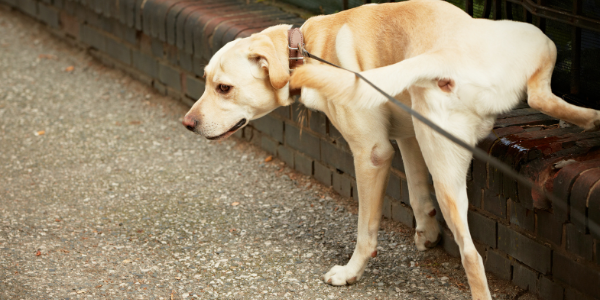
Reading the 'Pee Leaves'
Did you know that the way your dog is peeing — or not — can give you some important information about their urinary and even overall health?
This article will highlight some of the signs you may notice when your dog pees that could indicate that a veterinary visit is needed.
Skip to section:
Dog Straining While Peeing
If your dog is struggling or straining while they’re peeing, it could actually be a very serious emergency condition. Both male and female dogs can have their urethra (the tube that connects the bladder to the outside world) blocked by a urinary stone, scarring, inflammation, or even a tumor.
Male dogs can also suffer a urethral blockage from an overly enlarged prostate (more of a problem in male dogs that haven’t been neutered, as the prostate grows under the influence of testosterone).
You should always err on the side of caution if you see your dog straining to pee and bring them for immediate veterinary evaluation. Even if they’re not “blocked,” your dog will be happy that you had them checked to be sure.
Dribbling or Leaking Urine (after peeing or even when just lying down)
The cause of urine dribbling often depends on the age of the dog.
With puppies, it’s more likely that they’re dealing with an anatomical problem that they were born with. Two of the most common are a “patent urachus” (basically dribbling out of their “belly button” from a ligament that didn’t properly regress) and an “ectopic ureter” (on one or both of the ureters, the tubes that connect the kidneys to the bladder, doesn’t insert exactly where it should within the bladder wall).
With adult and older dogs, it’s often more of a problem with their control over their urethral sphincter, the muscle that helps keep pee in the bladder until the dog is ready to get it out. And, of course, dogs of all ages can get urinary tract infections that can sometimes result in urine dribbling.
Either way, persistent dribbling should be evaluated by your veterinarian. It’s typically not an emergency condition, but you shouldn’t let it go on for too long.
PRO TIP: When heading to the vet for an evaluation of urine dribbling, it’s helpful to be able to tell them if your dog is dribbling only when they’re laying down or asleep, or also when they’re walking around or even following regular urination.
It’s also helpful if you can let your vet know if your dog seems to have “conscious control” over their urethral sphincter, which is actually quite easy to test. Just startle your dog the next time they’re peeing and see if they can “cut off the stream” when startled.
Typically a simple clap, call of their name, or even gentle touch of their back will do… you don’t need to try and scare the s*!t out of them, that’s a whole other test!
Oh, and speaking of "other tests," marijuana toxicity, which is getting increasingly common in dogs, can also cause sudden urine dribbling. Learn more about marijuana and CBD in dogs.

Discolored Dog Urine
Normal dog urine should be yellow. The “shade” of yellow can normally range from pale or “straw-colored” to amber, based on your dog’s hydration status and a few other factors, but it should be yellow nonetheless.
Urine gets its yellow color from a substance called urochrome, which is a metabolized breakdown product of red blood cells.
Here’s what some of the “non-yellow” colors of urine could mean:
- Orange: Dog urine that is orange, or “orangish,” is typically a sign of icterus or jaundice, which is a result of too much pigment from the inside of red blood cells being present in the system.
This can be due to a problem with the liver or some of the other organs and structures around the liver, including the pancreas, or it could be a problem with the red blood cells themselves or something causing abnormal breakdown of the red blood cells.
It could also be due to dehydration or the foods your dog is eating, or medications they're on. Either way, because of the potentially very serious causes listed first, a sudden appearance of orange or “orangish”-colored urine warrants an emergency trip to the veterinarian.
PRO TIP: If your dog’s urine is orange, check their gums, the “whites” of their eyes, and the inside of their ear flaps. There’s a good chance that you’ll notice a yellowish discoloration of those structures, too.
- Red: If your dog’s urine is red or pink it means that there’s blood (either the intact red blood cells themselves or the pigment from within the red blood cells) in their urine. Some of the most common causes of red or pink discolored urine in dogs are inflammation and/or infection within the urinary tract (anywhere from the kidneys to the end of the urethra).
Other possible causes could be urinary stones, urinary tumors, trauma, foreign bodies (like foxtails … OUCH!!), or a bleeding problem (like from rat poison, cancer, liver failure, dysfunctional or too few blood platelets, and other possible causes).
Red or pink discolored urine warrants a veterinary visit immediately if there’s a lot of red discoloration or if your dog is otherwise not acting normally.
- Brown or Black: If you’re noticing a brown or black color to your dog’s urine, it most likely means that there’s been some significant damage to their muscles (like from trauma, prolonged seizures, or even from a metaldehyde-based slug and snail bait poisoning).
It could also indicate toxicity from ingestion of acetaminophen, the active pain-relieving ingredient in Tylenol®, Excedrin®, and several other products. If you’re seeing brown or black urine from your dog, it’s time for an emergency trip to the vet!
Increased Volume or Frequency of Urination
Increased Volume
A dog peeing a larger volume of urine can be normal, like if they’ve been drinking more recently because of the weather or increased exercise, if you’ve started adding canned food or water to their meals, or if your dog is pregnant.
However, an increased volume of urine can also be a sign of a problem (see the list below). If you’re noticing your dog peeing larger volumes, and it’s going on for more than a day and isn’t easily and reliably explained with one of the “normal reasons” mentioned above, then it’s time for a visit to your veterinarian for an examination and some blood and urine tests (and possibly even some X-rays).
Some medical problems that can cause an increased urine volume in dogs:
- Kidney failure
- Liver failure
- Heart disease
- Uterine infection ("pyometra")
- Excessive blood levels of calcium
- Brain tumors
- Cushing’s disease
- Addison’s disease
- Diabetes mellitus (“sugar diabetes”)
- Diabetes insipidus (“water diabetes”)
- Certain medications (e.g., Lasix or other diuretics, steroids, phenobarbitol)
Increased Urine Frequency
If your dog is asking to go out more frequently, is peeing more often when outside, or has suddenly started having accidents in your home, it’s likely that they’re battling with inflammation (possibly due to stress or urinary stones) and/or an infection within their urinary tract.
In most cases, this increased frequency is typically accompanied by smaller volumes at each voiding. This is because the presence of any urine within an inflamed or infected bladder is quite uncomfortable for a dog. For this reason, increased frequency of urination warrants a veterinary visit for evaluation.
PRO TIP: When dealing with an increased frequency of urination, you might be tempted to start your dog on a “urinary” or cranberry supplement. While they may help in some cases (see more about cranberry and your dog’s urinary health), they certainly don’t in all. And in many cases, delay in seeking veterinary evaluation and care prolongs the discomfort that your dog is experiencing.
Excessive Licking of Genitalia After Urination
While a little post-piddling “clean up” is normal in dogs, excessive genital area licking after urination or even throughout the day should be evaluated and worked up by your veterinarian. Here’s a list of some of the things that could cause excessive genital area licking in dogs:
- Urinary tract infection
- Perivulvar (the area around their vulva) infection
- Trauma of genitalia
- Tumor
- Foreign body (e.g., foxtails, grass)
- Constant urine dribbling or incontinence
- Preputial entrapment (condition in male dogs where fur — or even a rubber band, if you've got young kids — gets wrapped around their prepuce causing pain, possible infection, and the inability of the dog to urinate normally)
So there you have it, a list of some of the changes or abnormalities in the way your dog is peeing, what they might mean, and what actions you should take. I hope this helps you and your dog.
 PRO TIP: When bringing your dog into your vet’s office to have a peeing/urinary issue evaluated, try not to let your dog pee for a few hours before the exam. (And definitely not on the walk into your vet’s office!)
PRO TIP: When bringing your dog into your vet’s office to have a peeing/urinary issue evaluated, try not to let your dog pee for a few hours before the exam. (And definitely not on the walk into your vet’s office!)
This is because your vet is likely to want to collect as fresh of a urine sample as possible and may even want to collect a urine sample directly from your dog’s bladder (especially important if they want to submit a sample for a bacterial culture and sensitivity).
So try and arrive at your vet appointment with your dog’s bladder full, as that will make collection at the office easier (for your dog and the vet team) and more likely successful. In some cases, your vet may ask you to actually bring a sample of your dog’s urine to the appointment or drop one off beforehand. See how to collect your dog’s urine sample at home.



